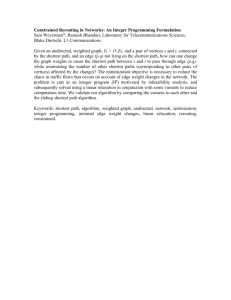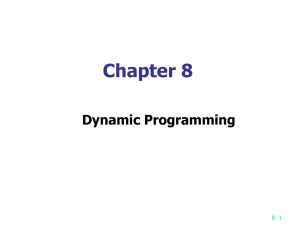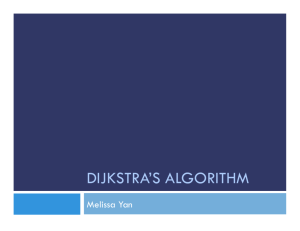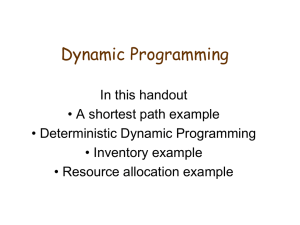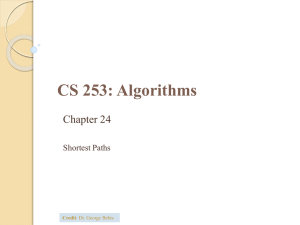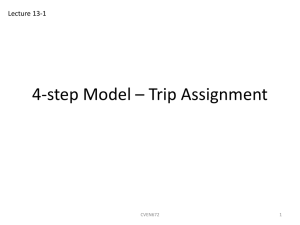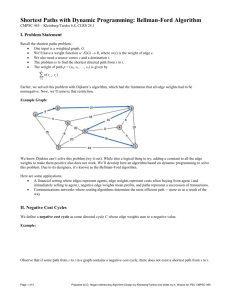Dynamic Programming
advertisement
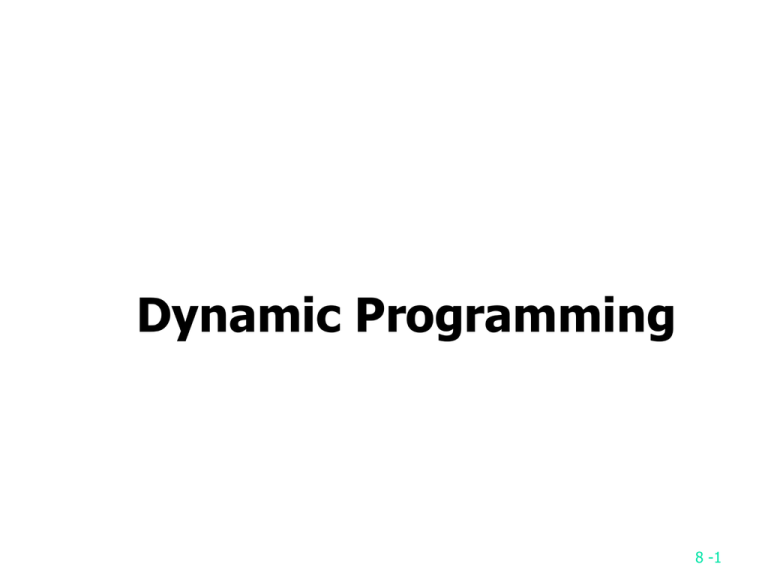
Dynamic Programming
8 -1
Fibonacci sequence
Fibonacci sequence: 0 , 1 , 1 , 2 , 3 , 5 , 8 , 13 , 21 , …
Fi = i
if i 1
Fi = Fi-1 + Fi-2 if i 2
f5
Solved by a recursive program:
f4
f3
f3
f2
f1
f2
f1
f1
f2
f0
f1
f1
f0
f0
Much replicated computation is done.
It should be solved by a simple loop.
8 -2
Dynamic Programming
Dynamic Programming is an algorithm
design method that can be used when
the solution to a problem may be
viewed as the result of a sequence of
decisions
8 -3
The shortest path
To find a shortest path in a multi-stage graph
S
3
2
1
4
5
A
7
B
5
T
6
Apply the greedy method :
the shortest path from S to T :
1+2+5=8
8 -4
The shortest path in
multistage graphs
e.g.
4
A
D
1
11
S
2
5
B
18
9
E
16
13
T
2
5
C
2
F
The greedy method can not be applied to this
case: (S, A, D, T) 1+4+18 = 23.
The real shortest path is:
(S, C, F, T) 5+2+2 = 9.
8 -5
Dynamic programming approach
Dynamic programming approach (forward approach):
1
S
2
B
5
A
C
d(A, T)
d(B, T)
T
d(C, T)
d(S, T) = min{1+d(A, T), 2+d(B, T), 5+d(C, T)}
d(A,T) = min{4+d(D,T), 11+d(E,T)}
= min{4+18, 11+13} = 22.
A
4
11
D
E
d(D, T)
T
d(E, T)
8 -6
Dynamic programming
d(B, T) = min{9+d(D, T), 5+d(E, T), 16+d(F, T)}
= min{9+18, 5+13, 16+2} = 18.
d(C, T) = min{ 2+d(F, T) } = 2+2 = 4
d(S, T) = min{1+d(A, T), 2+d(B, T), 5+d(C, T)}
= min{1+22, 2+18, 5+4} = 9.
The above way of reasoning is called
D
9
d(D, T )
backward reasoning.
B
5
16
E
F
d(E, T )
T
d(F, T )
8 -7
Backward approach
(forward reasoning)
d(S, A) = 1
d(S, B) = 2
d(S, C) = 5
d(S,D)=min{d(S, A)+d(A, D),d(S, B)+d(B, D)}
= min{ 1+4, 2+9 } = 5
d(S,E)=min{d(S, A)+d(A, E),d(S, B)+d(B, E)}
= min{ 1+11, 2+5 } = 7
d(S,F)=min{d(S, A)+d(A, F),d(S, B)+d(B, F)}
= min{ 2+16, 5+2 } = 7
8 -8
d(S,T) = min{d(S, D)+d(D, T),d(S,E)+
d(E,T), d(S, F)+d(F, T)}
= min{ 5+18, 7+13, 7+2 }
=9
8 -9
Principle of optimality
Principle of optimality: Suppose that in solving
a problem, we have to make a sequence of
decisions D1, D2, …, Dn. If this sequence is
optimal, then the last k decisions, 1 k n
must be optimal.
e.g. the shortest path problem
If i, i1, i2, …, j is a shortest path from i to j,
then i1, i2, …, j must be a shortest path from i1
to j
In summary, if a problem can be described by a
multistage graph, then it can be solved by
dynamic programming.
8 -10
Dynamic programming
Forward approach and backward approach:
Note that if the recurrence relations are
formulated using the forward approach then the
relations are solved backwards . i.e., beginning
with the last decision
On the other hand if the relations are formulated
using the backward approach, they are solved
forwards.
To solve a problem by using dynamic
programming:
Find out the recurrence relations.
Represent the problem by a multistage graph.
8 -11
The resource allocation
problem
m resources, n projects
profit p(i, j) : j resources are allocated to
project i.
maximize the total profit.
Resource
Project
1
2
3
4
1
2
5
4
2
2
8
6
4
4
3
9
7
4
5
8 -12
The multistage graph solution
A
0,1
B
S
0,2
0,3
1,1
7
6
4
F 4
0
1,2
0
5
C
2,1
4
5
J
1,3
G
0
2,2
4
K
0
3,1
T
0
5
4
H
0
2
2,3
9
D
4
4
6
8
I
0
5
0
2
E
0
3,2
0
L
3,3
The resource allocation problem can be described as a
multistage graph.
(i, j) : i resources allocated to projects 1, 2, …, j
e.g. node H=(3, 2) : 3 resources allocated to projects 1, 2.
8 -13
Find the longest path from S to T :
(S, C, H, L, T), 8+5+0+0=13
2 resources allocated to project 1.
1 resource allocated to project 2.
0 resource allocated to projects 3, 4.
8 -14
The traveling salesperson
(TSP) problem
e.g. a directed graph :
2
1
2
2
10
4
6
5
9
3
8
7
4
Cost matrix:
3
4
1
2
3
4
1
2
3
4
2
4
6
2
3
8
10
9
7
5
4
8 -15
The multistage graph solution
(1,2,3)
4
(1,2,4)
7
(1,2,3,4)
9
6
(1,2)
¡Û
(1,2,4,3)
4
2
3
10
(1)
(1,3,2)
¡Û
(1,3,2,4)
(1,3)
6
2
4
(1,3,4)
8
1
(1,3,4,2)
4
5
(1,4)
8
(1,4,2)
9
(1,4,2,3)
2
7
(1,4,3)
3
(1,4,3,2)
A multistage graph can describe all possible tours of
a directed graph.
Find the shortest path:
(1, 4, 3, 2, 1)
5+7+3+2=17
8 -16
The representation of a node
Suppose that we have 6 vertices in the graph.
We can combine {1, 2, 3, 4} and {1, 3, 2, 4} into one
node.
(1,3,2)
(1,3,2,4)
(2), (4,5,6)
combine
(1,2,3)
(1,2,3,4)
(a)
(4), (5,6)
(3), (4,5,6)
(b)
(3),(4,5,6) means that the last vertex visited is 3 and
the remaining vertices to be visited are (4, 5, 6).
8 -17
The dynamic programming
approach
Let g(i, S) be the length of a shortest path starting at
vertex i, going through all vertices in S and terminating
at vertex 1.
The length of an optimal tour :
g(1, V - {1}) min {c1k g(k, V - {1, k})}
2 k n
The general form:
g(i, S) min {c ij g(j, S - {j})}
Time complexity:
n
jS
n (n 1)(nn 2k )(n k )
k 2
( ),( )
n 2
(n-1)( n k )
(n-k)
O(n2 2 n )
8 -18
